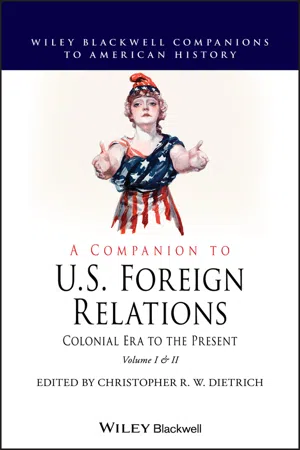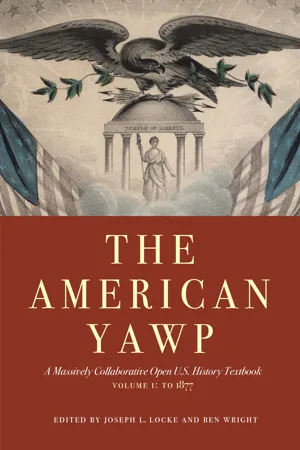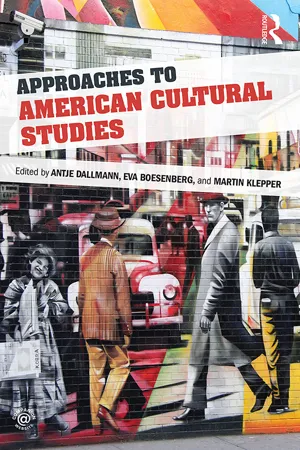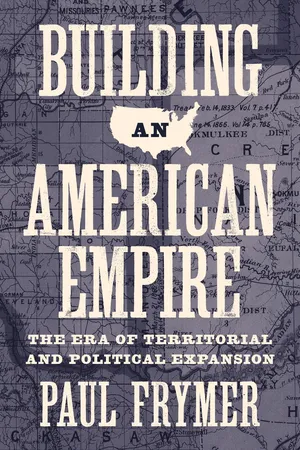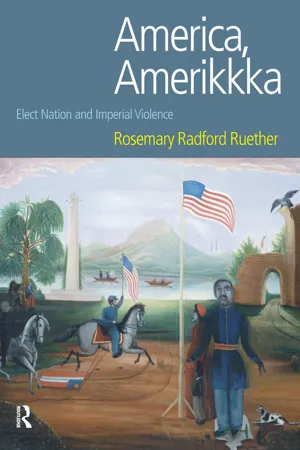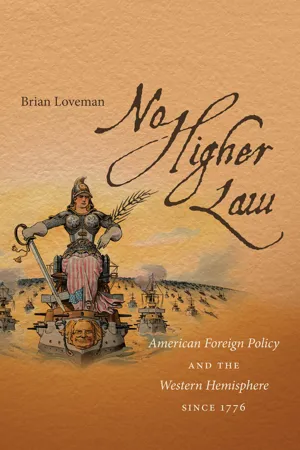History
Manifest Destiny
Manifest Destiny was a 19th-century belief that the expansion of the United States across the North American continent was both justified and inevitable. It was driven by a sense of cultural and racial superiority, as well as economic and territorial ambitions. This ideology led to the annexation of Texas, the Oregon Trail, and the Mexican-American War.
Written by Perlego with AI-assistance
Related key terms
10 Key excerpts on "Manifest Destiny"
- eBook - ePub
A Companion to U.S. Foreign Relations
Colonial Era to the Present
- Christopher R. W. Dietrich, Christopher R. W. Dietrich(Authors)
- 2020(Publication Date)
- Wiley-Blackwell(Publisher)
Chapter Seven Many Manifest DestiniesBrian RouleauOften lost in the voluminous historiography surrounding Manifest Destiny is the fact that the ideology was itself a theory of history. The Americans of the 1840s who coined the concept did so as a means to explain the country's expansion across the North American continent. Civilization, the theory went, marching steadily westward for centuries prior, had reached its apex in the United States, and so it became the special duty of Americans, their heaven‐directed fate, to spread their ideals and way of life across as much of the earth's surface as possible. A whole host of “interests” drove the nation's geographic enlargement. The political, strategic, and economic dimensions of that process cannot be dismissed, but neither can they be disentangled from the narratives Americans crafted regarding expansion. And that is how Manifest Destiny is best understood: as an ideology that explained to the republic's citizens why their growth across space was a good thing. It was a story the appeal of which, moreover, transcended the era in which it was created. Generations of Americans since the middle of the nineteenth century have seen “Manifest Destiny” as shorthand for an array of principles and processes marking the United States' supposedly exceptional place in the world.Manifest Destiny, then, is a concept with a very long career, and, significantly, many of its basic premises went largely unexamined well into the twentieth century. When, in 1893, historian Frederick Jackson Turner offered up his now‐famous address, “The Significance of the Frontier in American History,” he lent scholarly imprimatur to a sort of folk‐wisdom that had been entrenched in the United States since the early nineteenth century at least (Turner 1920 ). Turner's argument – in positioning westward expansion as the sine qua non of American history and democratic self‐government – echoed John L. O'Sullivan's grandiose claims, not to mention even earlier Jeffersonian and Jacksonian precursors, about a westering process that promoted individual liberty and strengthened republican values. A subsequent generation of students trained by Turner dispersed across the academy largely to reinforce most of their mentor's conclusions. Some, like Herbert Eugene Bolton, tinkered around the edges so as to challenge Turnerian assumptions. But injecting new concepts like the “borderlands,” as well as new players such as the Spanish, into what had been an “American” story did surprisingly little to dislodge the basic assumptions about nineteenth‐century territorial expansion (Bolton 1933 ). These were: a conception of the American people as particularly righteous; a conviction regarding the special genius of the country's representative institutions; and a religiously held certainty about Providence's plan to see that body of American values and practices spread across as much of the earth's surface as possible (Weeks 2013 ). Such were the essential tenets of Manifest Destiny, and, as a testament to the broad consensus surrounding them, they did much to shape the early historiography of territorial expansion. Since the 1950s at least, when William Appleman Williams published an influential essay on the subject (Williams 1955 - eBook - ePub
The American Yawp
A Massively Collaborative Open U.S. History Textbook, Vol. 1: To 1877
- Joseph L. Locke, Ben Wright(Authors)
- 2019(Publication Date)
- Stanford University Press(Publisher)
O’Sullivan and many others viewed expansion as necessary to achieve America’s destiny and to protect American interests. The quasi-religious call to spread democracy coupled with the reality of thousands of settlers pressing westward. Manifest Destiny was grounded in the belief that a democratic, agrarian republic would save the world.Although called into name in 1845, Manifest Destiny was a widely held but vaguely defined belief that dated back to the founding of the nation. First, many Americans believed that the strength of American values and institutions justified moral claims to hemispheric leadership. Second, the lands on the North American continent west of the Mississippi River (and later into the Caribbean) were destined for American-led political and agricultural improvement. Third, God and the Constitution ordained an irrepressible destiny to accomplish redemption and democratization throughout the world. All three of these claims pushed many Americans, whether they uttered the words Manifest Destiny or not, to actively seek the expansion of democracy. These beliefs and the resulting actions were often disastrous to anyone in the way of American expansion. The new religion of American democracy spread on the feet and in the wagons of those who moved west, imbued with the hope that their success would be the nation’s success.John O’Sullivan, shown here in an 1874 Harper’s Weekly sketch, coined the phrase Manifest Destiny in an 1845 newspaper article. Wikimedia.The Young America movement, strongest among members of the Democratic Party but spanning the political spectrum, downplayed divisions over slavery and ethnicity by embracing national unity and emphasizing American exceptionalism, territorial expansion, democratic participation, and economic interdependence.2 Poet Ralph Waldo Emerson captured the political outlook of this new generation in a speech he delivered in 1844 titled “The Young American”:In every age of the world, there has been a leading nation, one of a more generous sentiment, whose eminent citizens were willing to stand for the interests of general justice and humanity, at the risk of being called, by the men of the moment, chimerical and fantastic. Which should be that nation but these States? Which should lead that movement, if not New England? Who should lead the leaders, but the Young American?3 - eBook - ePub
Meeting the Enemy
American Exceptionalism and International Law
- Natsu Taylor Saito(Author)
- 2010(Publication Date)
- NYU Press(Publisher)
Colonizing the ContinentAway, away with all these cobweb tissues of rights of discovery, exploration, settlement, contiguity, etc. . . . [The American claim] is by the right of our Manifest Destiny to overspread and to possess the whole of the continent which Providence has given us for the development of the great experiment of liberty and federative self government entrusted to us.—John L. O’Sullivan, New York Morning News ,December 27, 1845The phrase “Manifest Destiny,” coined in 1845 by American lawyer, author, and adventurer John O’Sullivan, quickly assumed widespread popularity in mainstream discourse, for it evoked the earliest English settlers’ vision of a “new Canaan” and captured the essence of the United States’ claim to the legitimacy not only of its independent existence but its constant expansion.1 The expropriation of native land and the concomitant decimation of Indigenous peoples within the claimed territory of the United States, discussed in chapters 3 and 4 , provided the material base for the extension of U.S. hegemony over other peoples, and the rationale used to accomplish this consolidation “at home” has been extended subsequently to justify the global reach of U.S. power. More recently, the legacy of this peculiarly American vision of “Manifest Destiny” was reflected in George W. Bush’s 2002 statement that the war on terror “is our calling. This is our nation’s time to lead the world, and we’re going to do that.”2Early visions of American expansion were not limited to the territories contiguous to the original colonies. In 1783 Washington described the United States as a “rising empire,” and in 1786 Thomas Jefferson wrote that “our confederacy must be viewed as the next from which all America, North and South, is to be peopled.”3 Between 1803 and 1853, as a result of the Louisiana Purchase, the acquisition of Florida, the annexation of about half of Mexico, and the occupation of the Oregon territory, the United States extended its territorial claims to encompass all of what is now known as its “lower forty-eight” states. In 1867 it also claimed possession of Alaska by virtue of its “purchase” from Russia.4 There was, of course, continued resistance from Indigenous peoples in these territories, but in 1890, following the Wounded Knee Massacre, the United States declared the “internal frontier” to be closed.5 - Reginald C. Stuart(Author)
- 2004(Publication Date)
- The University of North Carolina Press(Publisher)
J ohn L. O’Sullivan, who coined the phrase that politicians and istorians have used to characterize mid-nineteenth-century pansionism—Manifest Destiny—argued that God had granted Americans use of the North American continent. The inherent virtues of agrarianism, American entrepreneurship, republican institutions, and a conviction that European countries would eventually retreat from North America reinforced the idea that the United States would extend its superior civilization throughout the continent. Manifest Destiny implied not simply territorial growth, but sanctified ideology and institutions.The idea of Manifest Destiny was not without its precursors. James Monroe had mused about fusing Anglo-Saxon North America during the War of 1812. When John Quincy Adams hinted at American continental dominion, he meant something like O’Sullivan’s concept. But O’Sullivan expressed a far more strident nationalism. And he hinted at America’s millennial role, an idea with wide appeal in the nineteenth century.O’Sullivan began his journalistic career with the United States Magazine and Democratic Review during the Panic of 1837. These were exciting times. American troops pursued the Seminole Indians in Florida. Prairie traders wound along the Santa Fe Trail and missionaries settled in Oregon. Southern and Western frontiersmen helped Texans establish an independent republic. The rebellions in Lower and Upper Canada seemed to imply another republican surge. During those years Americans were moving geographically and developing ideologically. A patriotic spirit and commercial optimism flourished despite the panic.O’Sullivan was a child of the times. He was well educated, a staunch Republican, something of a literary man, and subject to grandiose political visions. He had a naïve faith in democracy’s power to steer human nature toward social perfection and believed that the United States was destined to guarantee freedom to the world. He also had a strong sense of Anglo-Saxon superiority. This mélange of views and his turgid, fanciful rhetorical flights make him seem quaint. But he provides a clear window on his times. His magazine survived for years, although he wandered from journalism to Caribbean filibustering in the 1850s, to Confederate sympathizing in the 1860s. He died in obscurity.1The Anglo-American disputes that punctuated United States foreign policy after 1815 inflamed O’Sullivan’s nationalism. But his common sense survived. He sympathized with the provincial rebels of 1837–38, but stressed that they must determine their own political destiny. He warned against American intervention. Although he suggested that war with England was possible because of British intransigence in the disputed northeastern boundary between Maine and New Brunswick, his sense of Anglo-Saxon unity made the mere thought morally and intellectually repugnant.- eBook - ePub
- Antje Dallmann, Eva Boesenberg, Martin Klepper, Antje Dallmann, Eva Boesenberg, Martin Klepper(Authors)
- 2016(Publication Date)
- Routledge(Publisher)
Part III Concepts of nation building in American StudiesPassage contains an image 6 The myth of the American West, “Manifest Destiny,” and the frontier Michael J. Prince
The mythology of the American West contributes crucial elements in defining the United States historically and ideologically (for myth and mythology, see also Chapters 10 and 11 ). These elements are derived mainly from discourses that have, with their frequent retellings and progressively broader application, been diluted in their historical-material specificity to a set of stories with correlated icons, used to interpret Anglo-Europeans’ historical encounters with American space and peoples and the young nation’s territorial expansion.They often also provide the filters by which contemporary situations in American society are understood. On 17 September 2001, President George W. Bush drew on this myth cluster when he expressed how he thought Osama bin Laden should be brought to justice: “There is an old poster out West that said ‘Wanted: Dead or Alive’” (ABC News), thereby characterizing his adversary as an outlaw and suggesting a corresponding response.These myths may also broadly suggest a telos, a predestined goal for American society, of which the nineteenth-century declarations and policies of Manifest Destiny are but one historical example. They justified in terms of a religious predestination the coast-to-coast appropriation of the North American continent by white Anglo-American settlers.Cultural myth, then, is equipped so as to provide a series of self-reinforcing filters, narratives, and icons with which one can think about past events, present situations and future choices. The most redolent and widespread of the cultural myths in the United States are “progressive myths,” i.e., myths that naturalize a constantly expanding economy and an ever greater “integration” of people and resources into the economic matrix. Other cultural myths overlap with and support the myths of the American West, such as the “rags to riches” and “self-made man” narratives, which are discussed in Chapter 11 - eBook - ePub
- Stephen Mennell(Author)
- 2013(Publication Date)
- Polity(Publisher)
8 But Westward, Look, the Land is Bright: From Frontier to EmpireWhenever one looks at an historical process a posteriori, knowing what was the final outcome, it is difficult to perceive the uncertainties at each stage, the range of alternative outcomes that might have been. In retrospect, it may be hard to imagine how there could be any outcome other than a USA stretching from Atlantic to Pacific and between what are now the Canadian and Mexican borders. By the 1840s it already appeared inevitable to a good many Americans. Justifying expansion into Texas, Mexico and Oregon, the Jacksonian journalist John L. O’Sullivan wrote in 1845 that it was ‘by right of Manifest Destiny’ for the United States ‘to overspread and to possess the whole of the continent which Providence has given us’, both for ‘the development of the great experiment in liberty and federative self-government entrusted to us’ and for ‘the free development of our yearly multiplying millions’. If the phrase was new, the idea had been steadily forming for half a century. Thomas Jefferson (see p. 42 above) had from an early stage had his eye on expansion into the ‘free land’ to the west. And in 1812, just nine years after Jefferson had doubled the national territory through the Louisiana Purchase, John Quincy Adams wrote to his father:The whole continent of North America appears to be destined by Divine providence to be peopled by one nation, speaking one language, professing one general system of religious and political principles, and accustomed to one general tenor of social usages and customs. For the common happiness of them all, for their peace and prosperity, I believe it is indispensable that they should be associated in one federal Union. (Quoted in Remini, 2002: 44)Yet destiny had not always been quite so manifest. Looking back to the period between the Declaration of Independence and the adoption of the Constitution, John Adams wrote in his diary: ‘no-one thought of consolidating this vast continent under one national government’ (quoted by Kramnick, 1987: 18). So to what extent was the continental USA ‘inevitable’ or ‘accidental’, and how far was it the outcome of conscious plans or of unintended processes? - eBook - ePub
Princeton Studies in American Politics
The Era of Territorial and Political Expansion
- Paul Frymer(Author)
- 2017(Publication Date)
- Princeton University Press(Publisher)
Mexico’s failure to populate its border opened the territory up for the United States to sweep in, first with its settlers (as Lucas Alamán, Mexico’s minister of exterior and interior relations, suggested earlier) and later with military force. The scarcity of people loyal to Mexico in the territories that the United States acquired was additionally critical because the settler populations that inhabited Texas forced the hand of American domestic policy makers who were otherwise thwarted in their expansionist goals by their own nation’s sectional politics and racial divisions. Even when offered Texas and having conquered substantial Mexican lands by force, American governing officials continued to hesitate and balk outright at these further opportunities for territorial acquisition. This was most notably the case when lands were populated with what Americans perceived to be ample “nonwhite” populations, and Congress voted instead to acquire only the largely unpopulated lands where they believed they could promote settlement policies that would quickly establish “American”/“white” majorities.Manifest Destiny did not unite Americans motivated by power and dreams of grandeur, but instead divided the nation over what such acquisitions meant for the domestic politics of slavery and for the explicit goal of retaining the United States as a white nation.10 The intensity of racism among supporters of Manifest Destiny at the time has been importantly noted, as beliefs in eugenics, scientific racism, and religiously ordained hierarchies of peoples became common parlance in public debates and understandings of racial difference during the time. Rogers Smith titled his chapter in Civic Ideals on the time period, “High Noon of the White Republic,” when Americans “assigned true supremacy not just to whites but to northern Europeans, often lumped together as Anglo-Saxons.”11 Reginald Horsman remarked that supporters of Manifest Destiny saw themselves “as a separate, innately superior people who were destined to bring good government, commercial prosperity, and Christianity to the American continents and to the world. This was a superior race, and inferior races were doomed to subordinate status or extinction.”12But in understanding both expansion and failed expansion to territories south and southwest of the United States, I wish both to supplement and complicate these claims in two ways. First, the dominant strands of racial ideology of the period were importantly multidimensional with regard to expansion; while some racist politicians promoted Manifest Destiny, other racist politicians opposed expansion because they feared having to confront, interact with, and potentially incorporate populations they deemed beneath them and unfitting for the United States. The racial “orders” of the period were meaningful, using terminology that Desmond King and Rogers Smith have used to understand American ideological and institutional divisions over liberalism and ascriptive hierarchies. But the implications of such orders were messy and often contradictory.13 As Frederick Merk noted many decades ago, racism in the mid-nineteenth century not only drove but also powerfully limited, American territorial expansion.14 - eBook - ePub
- John Callaghan, Brendon O'Connor, Mark Phythian(Authors)
- 2019(Publication Date)
- Routledge(Publisher)
40This national mindset has it that it was America’s destiny to fill and subdue the virgin continent by expansion to the West. Success in this enterprise reinforced claims of exceptional potency and privilege, and so the perceived differences between the Old and New Worlds continued to amplify. A famous passage from J. Hector St. John de Crèvecœur’s Letters from an American Farmer, first published in 1782, provides perhaps the best characterisation of this emerging sense of exceptionalism:What, then, is the American, this new man? … He is an American, who, leaving behind him all his ancient prejudices and manners, receives new ones from the new mode of life he has embraced, the new government he obeys, the new rank he holds… . Americans are the western pilgrims who are carrying along with them that great mass of arts, sciences, vigour, and industry which began long since in the east; they will finish the great circle… . The American is a new man, who acts upon new principles. He must therefore entertain new ideas and form new opinions. From involuntary idleness, servile dependence, penury, and useless labour, he [the American] has passed to toils of a very different nature, rewarded by ample subsistence. This is an American.41As the republic developed, the process of westward expansion and notion of ‘Manifest Destiny’ gave added weight to this vision of America, with the settling of North America (including parts of what were Mexico) held to constitute the progress of liberty and the right to a continental dominance that was sanctioned by God and history.42The US Constitution itself was, of course, couched in universal truths and the colonial revolt that preceded its drafting saw the spread of ideas proclaiming America’s special mission. “We have it in our power”, said Thomas Paine, “to begin the world all over again.”43 In historian Arthur M. Schlesinger Jr.’s phrase: “Experiment gave ground to destiny as the premise of national life.”44 Protected from world affairs by its geography, preoccupied with conquering the North American continent, unable to play a significant role in the power politics of Europe and with no interest in doing so, within the newly-constituted United States “the theory of the elect nation, the redeemer nation, almost became the official creed.”45 - eBook - ePub
America, Amerikkka
Elect Nation and Imperial Violence
- Rosemary Radford Ruether(Author)
- 2014(Publication Date)
- Routledge(Publisher)
Manifest Destiny and American Empire: 1890-1934
DOI: 10.4324/9781315711201-5The last decade of the nineteenth century saw key turning points in a number of trends in American society. The frontier was seen as closing, ending the era of free land to the West. The two excluded peoples, Indigenous Americans and African-Americans, experienced a low point in their mistreatment. The Dawes Act (1887) and the massacre at Wounded Knee (1890) sought to eliminate American Indians as a separate and resistant people to American expansion. The Supreme Court decision Plessy v. Ferguson (1896) confirmed the legality of Jim Crow segregation (see Chapter Two ). At the same time immigrants from Eastern and Southern Europe poured into the United States, presenting a new ethnic and religious diversity that was seen as highly unwelcome by those who called themselves ‘native’ Americans; i.e., white Northern European Protestants.From the 1870s there was rapid urbanization and industrialization. The railroads, electricity, motion pictures, cable cars and petroleum began to transform daily life. Huge fortunes were made by a few, while the vast majority labored long hours in oppressive conditions for just a few dimes an hour. A few hundred men held fortunes of over $1 million, while more than 80 per cent of the U.S. working population made less than $500 a year. Farmers saw a sharp decline in commodity prices, while the high prices charged by railroads and food corporations left them in chronic debt.At the same time farmers and workers began to organize for better conditions. The Grange Movement, Northern and Southern Farmers Alliances and populist parties challenged tariffs and the gold standard that impoverished farmers. Labor unions led strikes for better wages and working conditions, often finding themselves shut out of factories by the armed militia of employers and the state. The Homestead Steel strike of 1892 and the Pullman strike of 1894 saw open warfare between workers and armed guards in which both were beaten and shot. The organized feminist movement also became increasingly visible in the 1880s, sparking a new rhetoric of anti-feminism that deplored declining fertility in the white middleclass and purported loss of virility in white males. - eBook - ePub
No Higher Law
American Foreign Policy and the Western Hemisphere since 1776
- Brian Loveman(Author)
- 2010(Publication Date)
- The University of North Carolina Press(Publisher)
Chapter Five The New Manifest DestinyThe race that gained control of North America must become the dominant race of the world and its political ideas must prevail in the struggle for life. — JOHN FISKE , American Political Ideas , 1880The Civil War bloodied the United States and threatened it with dissolution. It had not, however, cured the country of an inveterate belief in its special Providence and Manifest Destiny. Notwithstanding the postwar tribulations of Reconstruction, racial strife, cyclic economic crises, and labor conflict, the country’s leaders recast and expanded America’s regional and global mission while maintaining unilateralism as its basic foreign policy principle.1On Abraham Lincoln’s assassination in April 1865, Vice President Andrew Johnson (1865–69) assumed the presidency. Johnson had never been a Republican but rather a “Unionist,” and he was the only southerner not to leave the Senate at the outset of the Civil War. In his first annual message to Congress, he reaffirmed his faith in America’s Providential origin and destiny: “‘To form a more perfect Union,’ by an ordinance of the people of the United States, is the declared purpose of the Constitution. The hand of Divine Providence was never more plainly visible in the affairs of men than in the framing and adopting of that instrument. It is, beyond comparison, the greatest event in American history; and indeed, is it not, of all the events in modern times, the most pregnant with consequences for every people of the earth?”Johnson’s message dwelt primarily on the task of reconstruction at home, but he also included glowing reports on American commercial relations as well as technological and scientific cooperation with the emperors of China, Russia, and Brazil. He ended his message with a remarkable celebration of American exceptionalism, especially coming only seven months after General Robert E. Lee’s surrender at Appomattox Courthouse on April 9, 1865, and Abraham Lincoln’s assassination on Good Friday, April 14: “Where, in past history, does a parallel exist to the public happiness which is within the reach of the people of the United States? Where, in any part of the globe, can institutions be found so suited to the habitats, or so entitled to their love as their own free Constitution?”2
Index pages curate the most relevant extracts from our library of academic textbooks. They’ve been created using an in-house natural language model (NLM), each adding context and meaning to key research topics.
